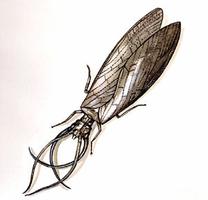
The dobsonfly is a large (100-140 mm), soft-bodied freshwater insect of order Megaloptera, family Corydalidae; smaller forms are called fishflies. Dobsonflies have 2 pairs of veined membranous wings, chewing mouth parts, long, many-segmented antennae and 3 simple eyes. Males have hornlike mandibles often 25 mm long. Dobsonflies are primarily nocturnal; closely related alderflies are smaller and diurnal.
Reproduction and Development
Dobsonflies deposit 2000-3000 dark brown eggs in rows forming large masses on objects near rapidly flowing water. Larvae hatch in 10-14 days, make their way into water and usually settle under stones or other debris. While adults do not feed and are short-lived, larvae are predaceous and take 2-3 years to develop. Fully-grown larvae leave the water to pupate in a cell in soil, moss, under stones, etc. Adults, appearing in early summer, are feeble fliers usually found near water and are short-lived.
Range
Six species occur in Canada: Corydalis cornutus found in southeastern Canada, with a wingspread of about 130 mm, is perhaps the best-known species.
Interaction with Humans
Larvae and adults are food for many fish and bait for anglers, particularly larvae of C. cornutus (sometimes called hellgrammite).

 Share on Facebook
Share on Facebook Share on X
Share on X Share by Email
Share by Email Share on Google Classroom
Share on Google Classroom



